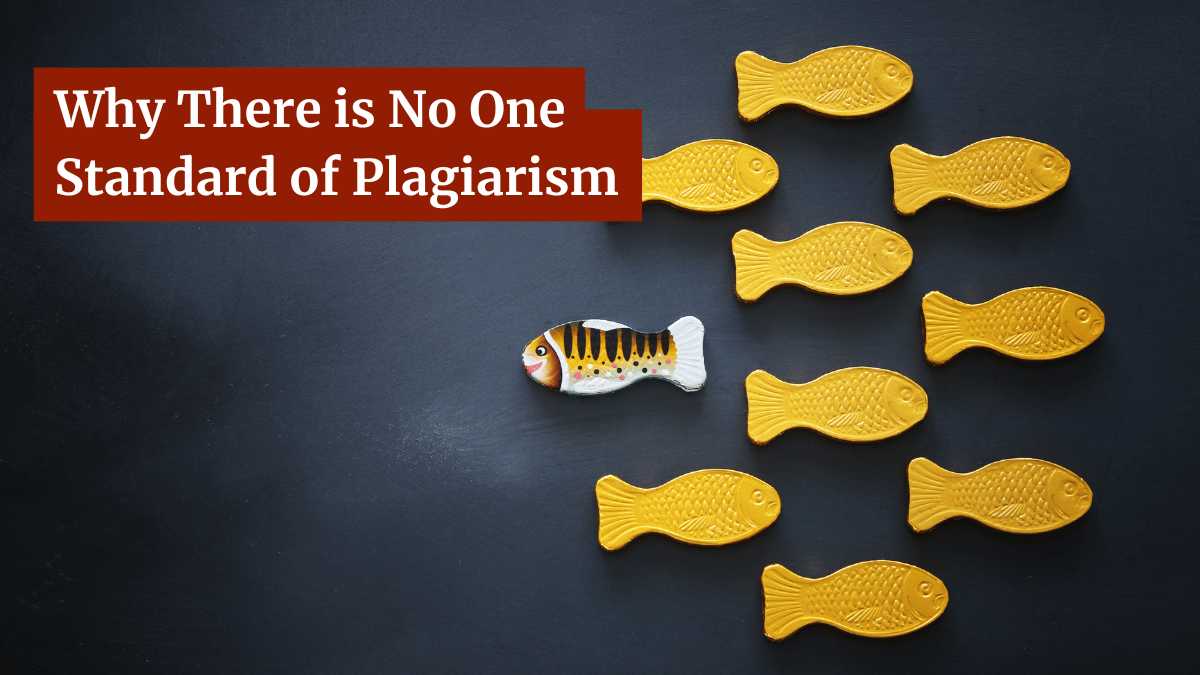Why There is No One Standard of Plagiarism

Citation norms are, fundamentally, a part of language. It is an element in how we communicate and how we separate our original words and ideas from those that we are pulling from elsewhere.
However, among language norms, citation is a rare beast in that doing it improperly can lead to serious ethical issues. Plagiarism, by its very nature, is the failure to provide inadequate citation or attribution, thus taking credit for the work of others, either directly or indirectly.
With so much on the line, it would be nice if there were a single standard for citation. However, those standards vary wildly in terms of what should be cited, when one should cite it and how it should be cited.
For example, a lawyer preparing a legal brief has a different standard than a novelist writing a work of fiction. They both have a different standard than a researcher publishing a scientific paper and that standard is significantly different than an average social media user.
But why is this the case? Why are there so many different standards of citation and plagiarism that students must learn how to code-switch based on what they are working on?
The reason is that different types of work have different goals and citation standards are usually crafted to achieve those various goals.
Originality Vs. Quality
In a 2020 essay looking at the ethics of plagiarism in the legal field, former ABA Ethics Counsel Dennis Rendleman explained why the field has a more relaxed view on copying than other writing-focused fields.
Rendleman explained that the legal field is not focused on the originality of arguments, but rather, the quality and the persuasiveness of the argument. In fact, producing an original argument could be detrimental to the filing and to the client.
This is backed up by a separate December 2023 article on Above the Law by Joe Patrice, who referenced a senior partner in saying, “exercising originality in word choice is often damn near malpractice.”
While there is obviously a great deal of debate about what does and does not constitute plagiarism in the legal field, generally speaking, greater reuse of ideas and text is permitted without attribution, than fields such as journalism, academic research, and creative writing.
The reason is, in part, the aforementioned dichotomy between being focused on quality and being focused on originality. Legal writing is largely intended to be functional, the goal is to present the best argument, not the most novel or original one.
This is somewhat similar to what computer programmers face. It is much more important that the code works properly than it be a new way to solve the problem. In fact, given the nature of programming, there may only be a limited number of solutions, making copied code not just a shortcut, but a necessity.
Compare that to fiction writing, where originality is much more highly prized. Though tropes and general plot points are often shared, once again because there is often a limited number of such elements, the work is expected to be original and a creative work of the author. It is much better to have a mediocre but original work than an effective but copied one.
Journalists, likewise, are expected to do original work and original reporting. Part of the journalist’s job is to vet and parse the information that they receive and simply repeating what other sources have already said fails to do that. This hits especially hard with press release plagiarism as well as plagiarism from other news sources.
This is not to say that you cannot commit plagiarism in programming or the legal field or that you can never copy when writing for a news organization or creating a fictional work. Instead, it speaks to the relative standards as to what copying is allowed, what citation is required and so forth.
But, while the originality/quality dichotomy goes a long way to explaining the differences, it does not explain everything. Scientific publication is a field where the quality of work matters far more than originality. A large percentage of research is based on earlier work, either replicating studies or doing slight variances to test other variables.
However, the scientific publishing world has perhaps the strictest citation standard of all. That is because authorship is independently important. For one, it matters to those in the field, whose careers can be directly impacted by the number of times they are published and the number of citations they receive.
Beyond that, scientific knowledge is built upon previous work and the ability to trace the history of an idea or discovery is important. It helps determine how solid the new work is and how much it should be trusted. Plagiarism, or even just lackadaisical citation, can break that chain, making such examinations impossible.
Likewise, students have a similar issue. The focus on academic writing is very much on quality and not originality, at least in most assignments. However, the goal of the assignments is to test the knowledge and comprehension of the student and that purpose is defeated if the student plagiarizes. As such, citation standards in the classroom are also extremely high.
In short, you can usually determine how strict the citation standards in a field will be with two questions:
- Is the primary focus of the field originality or quality of the work?
- How important is authorship either to the audience or the authors?
But, while this largely answers the questions of why the standards are different, it does not answer how those standards came to be.
How to Create a Citation Standard
In general, there are two ways to create a citation standard: Top-down or bottom-up.
We have seen both approaches in social media.
X (formerly Twitter), is an excellent example of a bottom-up strategy. The site began with a strict 140-character limit and users devised their own standards organically, such as the “RT @username” standard for retweeting earlier posts.
The site simply implemented standards and concepts that the users did. Though how those ideas are implemented has changed over the years, the DNA is still there.
Facebook, on the other hand, has always taken a top-down approach. They came out of the gate with their own share button and implemented their own system for linking to and tagging other Facebook users. Part of this can certainly be attributed to Facebook’s desire to capture as much user attention as possible.
That said, you can find plenty of examples of both in other fields. Journalists, for example, are very much top-down with the AP Stylebook being the most commonly used guide. Researchers and students alike are expected to use MLA, APA or Chicago style depending on the specific field.
But others were developed bottom-up. Computer programmers, for example, have largely developed their own standards for commenting and citing code. Though rigid standards may exist with certain companies and certain licenses, such as the GPL, many of the citation norms developed organically over time.
This included a famous example of programmers leaving Atari to form Activisim so that they could receive credit for their work. Much of the history of computer programming has involved programmers fighting for ways to get acknowledgement for their work, to the point of sneaking in attribution as an easter egg.
In the end, most citation standards, if they are built up long enough, end up becoming something of a hybrid of the two approaches. Many start organically but get codified through technology, legal agreements or other top-down approaches.
To be clear, both approaches have their advantages and drawbacks, but understanding how a standard was developed often helps understand what that standard is. That can be especially useful when you are creating something for an audience that is outside of your comfort zone.
Bottom Line
In the end, it would be nice if there were a single citation standard that everyone could learn, follow and not worry about. However, just like rules of grammar, etiquette and style vary from type of work to type of work, so do the rules for citation.
Those rules change because the purpose of the work changes. If you find yourself wondering if you should cite something or how you should cite it, thinking about why and how the citation standard developed might help lead you to the answer.
If you are still unsure, talk with others, in particular those in the intended audience or in positions of authority. For students, this means talking with your teachers, journalists, your editors and creative authors, your readers. A good faith conversation about citation is far better than turning in something that doesn’t meet the standards.
If that fails, then my usual advice is to either cite the content or omit it. Almost no one is ever punished for unnecessary citation, but failure to provide adequate citation is a form of plagiarism and is treated as such.
Citation is simply an area where a mistake can be too costly to ever justify the risk.
Want to Reuse or Republish this Content?
If you want to feature this article in your site, classroom or elsewhere, just let us know! We usually grant permission within 24 hours.
